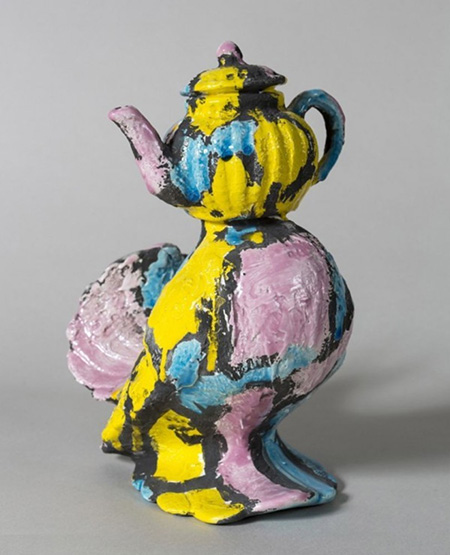
A collector couple’s visit to your studio is best initiated by the couple, whether straight or gay, young or old. Then you know they are really interested in you and not present merely as a result of your kind invitation. In fact, your dealer (assuming you have one) could set up the whole thing. It could be to educate the collectors about your achievements and prospects; it could be, as some collectors prefer, to preview your next show before it opens.
Again, you will be fully prepared with tons of work to show them, quality mineral water to offer, and comfortable seating. You want to make a good impression, of course, but do not overdress or outdress them for the occasion. You are not one of them; you are a working artist. Even if invited out to dinner by the couple afterwards, neither you nor your spouse or partner should ever look better dressed or groomed than your guests (they may already resent you for your youth and beauty).
I remember Michael Lucero, an acclaimed New York ceramic sculptor originally from California, and his wife, painter Cheryl Laemmle (also from California), navigating all sorts of collector couples in the 1980s and 1990s. Cheryl, who owned over 300 examples of clothing by Emilio Pucci, as well as dresses by Azzedine Alaïa (her only splurges after a few successful shows) would never go out of the loft wearing them if they were dining with collectors. Michael always wore the same thing: well-cut jeans or trousers and a baseball cap that never came off, even indoors.
Things could get thorny. According to Lucero, collectors Herbert and Dorothy Vogel (who had no children of their own) thought they were “adopting” the Luceros, but Michael routinely picked up the tab at Chinese restaurants they frequented with the older couple. This did not stop the Vogels from acquiring their artworks, but neither Lucero nor Laemmle was acquired when the Vogel collection was sold to the National Gallery of Art for $2 million.
Another couple, Stephen and Pamela Hootkin, are among the leading ceramic art collectors of the era (everything is going to the Chazen Museum at the University of Wisconsin—Madison).
Hootkin recalled various studio visits in an interview: “We would go to bombed-out places in the Bronx or the East Village [where Lucero lived]. We were very adventuresome. The artist would put out work, but we’d always be very snoopy and want to look at things in the back room.
“Sometimes an artist would call us to preview a new show in their studio. And some artists we sought out. Others were referrals from dealers or other artists, but basically we built relationships, so often they would feel comfortable about contacting us because they knew we had an interest. We wanted to form long-term relationships with the artist — and that’s what we did.”
What about acquiring works from the studio? Hootkin responded: “Yes, sometimes we bought right there and other times the artist would say, ‘This is going in a show,’ and he’d call the gallery … We felt in those days it was like buying a good stock and sitting on it for thirty years. I’m not sure the artists knew that we never ever sold a piece. This matters.”
What advice should collectors give about studio visits? Hootkin was evasive: “We don’t like to give advice. Collectors should not have any input into artists’ ideas. Our goal is to always have wonderful experiences and discussions. Occasionally, the artist would ask us what do [about a given work], but we’re just a couple with an interest in art and building a collection.”
Should artists cold-call collectors or approach them in person about studio visits? Hootkin mentioned that “We’ve received unsolicited letters in the mail but it really doesn’t work unless they know we have a prior interest. Then we might respond.”
The pragmatic thing for artists to remember is that it is never an equal relationship: the balance of power is always a delicate tension between demand and gratitude. Both parties need one another for long-term legitimacy, validation, and success. The collector couple can be a postal service worker and a public librarian (like the Vogels) or a JPMorgan Chase executive and a men’s wear industry CFO (like the Hootkins), ranging across the entire middle-class spectrum. Herbie Vogel would stoop to pick up scraps of paper off the studio floor and buy them (or ask for them), according to Lucero. Instead, the Hootkins preferred to pick up the check — at Café des Artistes — and always paid for the art. They wanted to celebrate a new acquisition with Michael and Cheryl, their younger, different friends.
